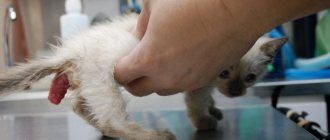What is cat sterilization, main types
In everyday life, sterilization is understood as an operation as a result of which the cat’s sexual instinct disappears.
Due to some confusion in the terms “castration” and “sterilization” (in the first case, all reproductive organs will be removed, and the second implies limited manipulation), in what follows we will talk about sterilization of a cat as a general concept. Pregnancy can be prevented in cats by surgical and chemical methods. Among the operational effects, the following types of sterilization are distinguished:
Cat sterilization surgery
- removal of the ovaries (used if the cat has not given birth);
- removal of the ovaries and uterus (used for individuals who have given birth, as well as for medicinal purposes according to indications);
- removal of the uterus (rarely performed, since the production of hormones and corresponding behavior are preserved);
- ligation of the uterine tubes (also rarely done, due to the preservation of hormone levels and the development of complications).
An alternative method of surgical intervention is the use of hormonal chemicals in the form of drops, tablets or injections. Depending on the amount of the active ingredient and the composition of the products, they can suppress the sexual instinct for 1 to 6 or more months.
Most veterinary specialists advise resorting to surgery once, rather than giving the cat hormonal drugs throughout its life. This is due to lower financial costs and fewer complications.
Attention: frequent use of hormonal drugs threatens the development of oncological pathologies, digestive, neurological and endocrine disorders, and in the event of pregnancy - congenital anomalies of the fetus, miscarriages.
When not to sterilize
If the offspring does not survive after birth, the cat cannot be sterilized immediately. According to the recommendations of veterinarians, it is necessary to wait at least 2 weeks. If an animal feeds kittens, then subjecting it to such a procedure is prohibited. After surgery, they can injure the mammary glands, which can subsequently lead to infection of the sutures. Therefore, it is advisable for the mother to feed the kittens, and then the uterus and ovaries can be removed.
In addition, during the procedure, the doctor may damage the milk ducts, causing milk production to stop. The process of natural feeding stops, and the owners begin to feed the kittens. This will require special food for newborns and special care for pets.
If the cat does not want to feed her offspring, then there is still no need to rush into surgical intervention. Such an operation is associated with risks to the health of the animal, including death. After sterilization, the pet ceases to be interested in her kittens, does not pay attention to them, and does not train them. She can also treat them with aggression, perceiving them as someone else’s cubs.
Pros and cons of sterilizing cats
There are both pros and cons to neutering cats, as outlined in the table below.
pros
- You don't have to get rid of kittens.
- The animal's behavior will not cause any inconvenience.
- Timely sterilization helps to increase the life expectancy of your pet.
- It is possible to prevent the development of many diseases of the cat’s reproductive system associated with estrus without mating, childbirth and hormonal changes.
- The risk that your pet will get lost or become infected with an infectious disease in case of escape is reduced to a minimum.
Minuses
- Surgery under anesthesia is stressful for the animal’s body.
- The likelihood of complications developing in the postoperative period.
- The risk of developing obesity, diabetes and other diseases associated with changes in hormonal levels.
- Recovery takes a long time (about two weeks) and requires constant wearing of special devices.
- If the owner “changes his mind”, it will be impossible to restore the ability to give birth to kittens.
Nutrition for castrated cats
After a certain period, the cat’s behavior and actions change, often the pet becomes more gentle and balanced, and is less drawn to the street. At the same time, hunger increases; this fact must be looked at especially carefully, because neutered pets are predisposed to obesity.
To balance energy metabolism, the number of calories is reduced by 25-30%. Fish is excluded from the diet, the supply of dry food is reduced or abandoned altogether. You also need to avoid fried, salty and fatty foods. You can feed them with porridge, boiled lean meat or special food for castrated animals.
At what age can a cat be spayed?
When asked when it is better to sterilize a cat, veterinary experts answer: at 7-8 months. It is believed that it is during this period of animal development that all organ systems are fully formed, the cat is ready to conceive, but there has not yet been pregnancy.
Puberty of a pet can occur earlier or later than the specified period. To determine the optimal interval, you will need to periodically show her to the veterinarian and do examinations. Performing surgery on an adult cat or a very young one is fraught with serious complications and health problems in the future.
Indications and contraindications for sterilization
In addition to the fact that sterilization of a cat is carried out due to the desire of the owner, the operation can have a therapeutic purpose and be planned or emergency. Among the indications:
- neoplasms in the reproductive organs;
- inflammatory processes;
- changes in the mammary glands caused by hormones;
- poorly performed earlier sterilization;
- prevention of various diseases (tumors, cysts, purulent processes, and so on).
Sterilization is not carried out if the cat has:
- age less than 6 months or older than 10 years;
- CVS pathologies were identified;
- estrus;
- pregnancy;
- inflammatory processes in the body and some other disorders.
Such contraindications to surgery relate mainly to cases of normalization of the cat’s behavior and elimination of the sexual instinct. If we are talking about preserving the life of an animal (for example, during an abnormally developing pregnancy), then sterilization becomes justified.
Why is sterilization necessary?
The need for sterilization of cats by veterinarians is beyond doubt; thanks to this simple procedure, many problems can be solved.
Sterilization is the deprivation of a cat's ability to reproduce.
Positive aspects of sterilization:
- According to statistics, animals that have undergone surgery to deprive them of the ability to reproduce live 2-3 years longer than unsterilized cats. This is explained by the absence of stress associated with hormonal surges. As well as pregnancy, childbirth and breastfeeding, which wear out the body and make it vulnerable to pathogens.
- Infection with sexually transmitted infections is minimized for sterilized animals. In addition, the likelihood of tumors, cysts and other pathologies of the uterus and ovaries is practically reduced to zero. The likelihood of developing neoplasms (including malignant ones) in the mammary glands is reduced by 50%.
- Raging hormones make the cat aggressive, restless, she rushes around in search of a cat to continue her family, and may begin to mark things in the apartment. Such behavior brings a lot of trouble to the owners and the animal itself. Sterilization ensures a loss of interest in breeding and concentrates the cat's attention on interacting with people. The pet becomes affectionate and easy to train, its character becomes calm and balanced, it stops marking everything around, which makes keeping the animal much easier.
- A cat is able to give birth up to six times a year. Moreover, up to nine cubs can be born in one lambing. Such fertility becomes a real disaster for the pet's owners and complicates the already difficult situation with homeless animals on the streets. Sterilization is the most civilized way to solve the problem of the birth of unwanted offspring.
© shutterstock
How to prepare a cat for sterilization
Sterilizing a cat requires preliminary preparation. Except for clinical cases, the animal must be absolutely healthy. This is especially true for vaccinations and antiparasitic treatment.
Vaccination must be carried out at least a month before surgery. It significantly reduces the risk of developing infectious complications in the postoperative period, when the pet’s immune system is weakened. In the absence of vaccinations, before the intervention, the cat is given a serum injection, which ensures stable functioning of the immune system over the next 14 days. Anthelmintic measures are carried out at least 10 days before sterilization.
Preparatory measures also include:
- laboratory tests of urine and blood;
- ultrasound examination of the reproductive organs;
- cardiogram.
At the discretion of the doctor, X-rays, respiratory examinations, and others are additionally prescribed.
Important: immediately before surgery, the animal must be limited in food (8-12 hours before) and water (3 hours before).
You should take care in advance about the carrier in which the cat will be transported from the clinic to home. Additionally, you will need an absorbent diaper in case of involuntary outflow of urine, as well as a sheet or blanket to prevent hypothermia.
Examination of a cat before sterilization
Types of sterilization
Each owner himself chooses the method of sterilization if he has a girl, and castration if he has a boy. If we talk about the first method, as noted above, it involves removing the ovaries. At the same time, the cat does not lose its instincts, the hormonal development and psycho-emotional state of the cat remain normal, the cat is only physically limited.
During a hysterectomy, the cat's uterus is removed, but the ovaries are retained; subsequently, all the cat's natural instincts are preserved; the cat simply becomes infertile. Veterinarians do not strongly advise using this method, since the consequences of this operation have a negative impact on the future health of the cat.
And finally, the third option. Having studied the reviews of veterinarians, we can make a clear conclusion that this method is the most effective and safe for sterilizing animals. This is an ovariohysterectomy - a surgical method in which all reproductive organs are completely removed. This operation is usually performed on cats that have already given birth once.
The procedure for sterilizing cats: methods and features
How cats are sterilized depends on the method chosen. There are three ways to perform the operation.
- Classic method. It is a skin incision in a previously prepared area along the white line of the abdomen slightly below the navel. The length of the incision is about 3 cm. This method allows you to remove both the uterus and ovaries. Its advantage is the possibility of direct access for a specialist to the cat’s organs. The disadvantage is the long length of the suture, which can provoke infection and bleeding.
- Using a side cut. Dissection of the abdominal cavity is carried out on the side of the midline of the abdomen, with the length of the wound not exceeding 1 cm. The method is not very convenient for performing manipulations and is used in situations where the classic option is not possible, or for tubal ligation. The advantage of the method is the rapid healing of a small incision, which reduces the risk of postoperative complications.
- Laparoscopic sterilization of cats. It makes it possible to remove both the uterus and ovaries through a small puncture in the abdominal wall. The entire process takes place using a special device, and the doctor’s actions are displayed on the monitor screen in real time. The method is characterized by minimal trauma to animal tissue, a reduced recovery period and a low likelihood of complications. However, it is rarely used, since it presupposes the availability of appropriate equipment in the clinic and the skills of a veterinarian, which ultimately adds up to the high cost of the procedure.
Each type of operation is performed under anesthesia, and the time for sterilization of cats is determined by the chosen method and can range from 15-20 minutes to one hour or more.
Advantages of puncture surgery
Endoscopic surgery has many advantages.
- The cat's tissues are minimally injured (that is, this operation is almost atraumatic),
- Minimally invasive,
- The operation is easier for animals to tolerate and reduces the rehabilitation process,
- Spot seams require almost no maintenance.
- It is especially relevant in smooth-haired breeds,
- The approximate time for such an operation is only 15-30 minutes. The operation time is so short due to time savings. There is no need to apply postoperative sutures.
- The vessels and ligaments of the ovaries are cauterized rather than ligated with sutures. This ensures that the cat's body does not reject the foreign body.
- The veterinarian must examine the stump, which will become the cat’s genitals, for bleeding. If classical, cavity sterilization is carried out, this is not possible.
- There are simply no postoperative sutures. That is, there is nothing to disagree about.
- There is an extremely small list of contraindications for this operation (endoscopic sterilization). Very old age of the animal, lung and heart diseases, some chronic diseases. Therefore, in most cases, those wishing to perform this operation on their cat are asked to perform a series of examinations on their cat: ultrasound of the heart, biochemical blood test, x-ray of the lungs.
- With this type of sterilization, it is possible to simultaneously conduct a full examination of your cat’s abdominal cavity.
- It is also possible to conduct a biopsy; sometimes this examination can reveal some pathological process.
Sterilize a cat at home
There are two ways to sterilize a cat in St. Petersburg - standard surgical, in which an incision is made on the stomach, and you can also perform laparoscopic sterilization of cats. In the second case, punctures are made on the animal’s stomach, through which the surgeon does all the work. With laparoscopy, the recovery period is significantly reduced.
If you need to sterilize cats in St. Petersburg, but you don’t know where to turn, then we offer you the services of highly qualified specialists who will perform surgery quickly, accurately and with minimal risk to the animal. In addition, we offer you such a service as sterilization of cats at home in St. Petersburg.
If you do not have the opportunity to visit a veterinary clinic, then an on-site doctor will be able to solve your problem. In this case, you will need to prepare the place and good lighting. Sterilizing cats at home is an excellent alternative option for both the animal and its owners. At home, your pet will be able to undergo the operation without additional stress, and the absence of a long journey immediately after the operation will prevent the sutures from coming apart. Contact us and our best doctors will sterilize your cat at home and provide you with all the necessary instructions for caring for your animal during the recovery period.
How to care for a cat after sterilization
Few owners have a complete idea of what to do after sterilizing a cat. Meanwhile, it is the postoperative period that determines the further state of the pet’s health.
If it is not possible to leave the cat in the clinic for the first few days, and she is “discharged” home immediately after the operation, you need to learn in detail all the nuances of care from a veterinarian. Depending on the pet’s condition before and after the intervention, she may be prescribed antibacterial drugs, anti-inflammatory drugs or painkillers. In addition, the specialist will tell you when (and whether) you need to come to remove the stitches, how often to do dressings, what products are best to use in this case, and other information. It would be good if the veterinarian can give his phone number so that in case of a sharp deterioration in the condition, he can be contacted without delay.
Features of transporting an animal from the clinic
You need to take your cat home not in your arms, but by placing it in a special carrier that has a flat and even bottom. Any shaking or displacement of the torso can cause the seams to separate. It is advisable to cover the animal with a light blanket or warm cloth, since due to the operation and anesthesia, the pet’s body temperature becomes lower than normal.
Where is the best place to place a cat in an apartment?
While the cat is recovering from sterilization, it is best for her to be on the floor. The owner needs to arrange the bed in advance: choose a spacious place where no one can disturb the animal, lay down a blanket, and put waterproof diapers on top. To ensure free flow of saliva, the pet should be placed on its right side.
It is imperative to ensure that the place reserved for the cat is not in a draft or near a heating device. However, you will still need to cover it; to do this, just take a light but dense fabric.
What to wear on a cat after sterilization
Cat in a blanket after sterilization
After sterilization, the cat's stomach should be isolated from the external environment to avoid infection of the wound. To do this, use a blanket - special clothing with slots for paws, fastened with Velcro or tape on the back of the animal. The device should be worn for about 10-14 days, depending on the complexity of the operation, the condition of the seam and other nuances.
Cat blankets should be washed, ironed, and then put on again. Such clothing is removed only to treat the surgical wound. To prevent your pet from taking it off, there should be no threads or loose ends of ties sticking out on the blanket. The product is selected only according to individual sizes, since the animal will easily remove a wide blanket, while a narrow blanket will interfere with blood flow.
Some owners sew such bandages themselves. Sometimes tights or socks are used as a means of improvisation, having previously cut holes. Whether the cat will wear such a blanket is unknown. Judging by the stories of owners on the Internet, many animals stage concerts or behave aggressively, even without fully recovering from anesthesia. As a result, the blanket is replaced with a collar, and the bandage on the wound is fixed with a plaster.
Coming out of anesthesia
The cat's behavior after surgery becomes inadequate and unpredictable due to anesthesia. During the first 1-2 days, the animal should not be left alone for a long time. Coming out of a narcotic state is accompanied by complete disorientation in space, staggering, wobbly limbs, screaming, meowing, aggression and other manifestations.
The duration of recovery of a cat from anesthesia can range from 5-6 hours to a day or more. But the pet usually begins to come to its senses 2-4 hours after the operation. There is no need to give her anything to drink, much less eat, at this time. It is allowed to moisten the oral cavity with water from a spoon or syringe.
How to feed a cat after sterilization
It is prohibited to feed the cat within 24 hours after sterilization. This is associated with the risk of a gag reflex (due to anesthesia) and decreased intestinal activity. Any contraction of the abdominal muscles or intestinal wall can lead to the opening of the wound or provoke intra-abdominal bleeding. Liquid food in the form of broth, meat ground and mixed with broth, porridge with water can be introduced into the animal’s diet approximately on the second day. You will need to follow a liquid diet until the stitch is removed.
If your cat refuses food and water
The first day after sterilization, the pet may not have an appetite. The alarm should be sounded if the cat does not eat or drink for more than 2 days, and all attempts to give it liquid food or water using a syringe end in failure. To recover, she definitely needs to take at least broth. To prevent dehydration and exhaustion of the pet, the owner should contact the clinic - an alternative may be intravenous nutrition.
Toilet problems
It happens that a cat does not go to the toilet after sterilization. If this happens within 1-2 days after surgery, then there is no need to worry. Due to preoperative fasting and dehydration, she simply has nothing to empty her bowels with. Other reasons for this phenomenon include:
- stress from surgery;
- the effect of anesthesia or drugs;
- the blanket gets in the way;
- the seam hurts.
Lack of bowel movements with normal appetite may indicate constipation. In this case, laxatives and a liquid diet will help. If your cat continues to have problems with the toilet more than 3 days after sterilization, you should immediately consult a veterinarian.
How can you tell if a cat is sterilized?
Determining whether an adult cat is sterilized is quite difficult. The most reliable method is long-term observation of the animal’s behavior. What is the likelihood that your new pet has already been spayed?
First, observe how the cat behaves in the home. If your pet knows well what window sills, bowls and upholstered furniture are, there is a high probability that she was once a pet. Another sure sign is consistent visits to the litter box.
The next step is to monitor the situation in your city for volunteer movements, the presence of protective organizations and government programs for sterilization of cats. Typically, if a cat is neutered and then returned to its habitat, it is marked:
- They put a brand in the ear - it looks like a tattoo, consisting of numbers and letters.
- The edge of the ear is cut off - after sterilization, the veterinarian carefully folds the cat’s ear in two and cuts off a corner. A neat, v-shaped cutout is obtained on the cat's ear.
If the cat was domestic and its previous owners neutered it, most likely you will not find any marks. What to do next? Let the animal get enough and sleep. As soon as the pet comes to its senses a little, it must be shown to the veterinarian, as it may be pregnant.
After an examination by a veterinarian, you will have approximate information about the animal’s age and state of health. Most likely, the doctor will insist on carrying out extraordinary preventive measures to get rid of parasites and revaccination.
If you are lucky and the cat you have chosen is not pregnant, you should not rush into sterilization. It is advisable to observe your pet for 4-6 months to be sure of its sexual activity. Unfortunately, veterinarians quite often discover that a cat has already been sterilized only after opening the abdominal cavity.
Note! Large veterinary clinics employ highly specialized ultrasound doctors who, with high-quality equipment, can detect the uterus and ovaries of an unsterilized, non-pregnant cat.
Behavioral signs
If you pick up a young or mature cat during the winter, she may behave quite calmly. The period of sexual heat in cats begins with increasing daylight hours, that is, in the spring and lasts until late autumn. Closely monitor your cat's behavior as soon as it starts to warm up outside. If the pet shows signs of heat, it is highly likely that she is not sterilized.
In rare cases, some cats are very calm during heat. The pet may not show signs of sexual heat: do not scream, do not mark the territory and do not roll on its back. However, at the peak moment of sexual heat, all females stand on their front legs, raise their pelvis and throw their tail to the side. While in this position, the cat begins to quickly move its hind legs and stomp.
If you pick up a very young cat, she may enter the heat period a little later. Females are usually ready to mate once they reach 80% of their adult weight. Owners of outbred cats should pay special attention to the behavior of their pets, since they can reach sexual maturity at the age of 4–5 months.
If your cat is not in heat, she may be neutered or sick. Contact your veterinarian to examine your animal, especially if you notice a decrease in activity, poor appetite, deterioration in coat quality, or other alarming symptoms. Sexually mature, uncastrated cats may not go into estrus if they have inflammatory diseases of the genitourinary system and hormonal disorders. Poor quality care and a state of constant stress can also contribute to a decrease in the pet’s sex drive.
What complications occur after sterilization of a cat?
Despite the simplicity of the operation, removal of a cat's reproductive organs can lead to complications. One of the most common is a lump on the stomach. It can occur due to swelling of soft tissues or excessively dividing young cells necessary for healing of the suture. In these cases, the lump after sterilization is not dangerous and gradually disappears on its own. But if the formation occurs as a hernia of internal tissues through a suture, then emergency surgery will be required.
Other possible complications after sterilizing a cat include:
- allergies to pharmaceuticals;
- deterioration in the functioning of the kidneys, heart, liver due to anesthesia;
- bleeding;
- neoplasms (in the long-term period).
The development of complications depends not only on the quality of the operation or the method of its implementation, but also on other nuances: at what age the cat is, its state of health at the time of the procedure, postoperative care, and so on.
Sterilization methods
There are different methods of sterilization. Not all of them are equally widespread and effective. Preference should be given to the one that the veterinarian who will be performing the procedure best specializes in.
Medication sterilization
To correct behavior, owners often use hormonal drugs that are designed to stop sexual hunting. Veterinarians strongly discourage the use of such medications.
Hormonal drugs do not have the best effect on the general condition of the female’s body. In addition, they only increase the risk of diseases of the reproductive system.
There is another method of medical sterilization, in which a special drug is injected under the skin of the cat. It is slowly dissolving. The effects of one injection can last for three years. This method is used for cats that have breeding value and will be involved in breeding in the future.
After a while, the functioning of the reproductive system is completely restored. This method is also effective if the cat has any contraindications to surgery related to its health condition.
Classic method
The incision is made at a distance of 2-3 cm from the navel along the so-called white line. There are not many blood vessels or nerves, so there is virtually no bleeding after the incision. The uterus is removed through the incision. A ligature is applied to the vessels. Next, the uterus is cut off. Removable or permanent sutures are placed on the skin.
You might be interested in: Cat's eyes turn sour: what is the reason and how to treat?
Sterilization through a side incision
This method is almost identical to the classic one, only the incision is made from the side. It is believed to be less traumatic and heal faster. However, this method may cause bleeding. In addition, this method is not very convenient for removing the uterus, so it is most often used only for castration - removal of the ovaries.
Laparoscopy
A very expensive method, which is not practiced in all clinics, since it requires special equipment. Two punctures are made on the cat's stomach, into which a camera and a special apparatus are inserted. The main advantage of this method is that the incision is very small, it does not require stitches and heals quickly. However, it is not always possible to completely remove the uterus through such a small incision. Most often, only the ovaries are removed during laparoscopy.
Features of sterilization of cats for different body conditions
Sterilization of a cat must take place in accordance with certain requirements for its age and hormonal status. However, there are situations when there is a need for surgery during pregnancy, estrus and other conditions. The owner must know in what cases this is permissible and what the dangers are.
During heat
Removal of reproductive organs during this period is not recommended, since a sharp change in the hormonal levels of the cat’s body will negatively affect its future health. The recovery period will also be longer and more difficult; the risk of developing postoperative complications increases.
Veterinary experts recommend sterilizing a cat a week after the end of estrus and no later than 2 weeks before it starts.
During pregnancy
Sterilizing a pregnant cat is also fraught with negative consequences. It is justified only in the following cases:
- abnormal development of fetuses;
- a cat disease caused by pregnancy that threatens its life;
- the animal is not able to bear kittens due to health conditions or age.
After childbirth
Sterilization of cats after birth must be carried out in accordance with certain rules:
- if the pet does not feed the kittens, you should wait about a month;
- if the cat is nursing, then you will need to wait 2 to 3 months after giving birth.
The most suitable time to sterilize an animal after lambing is 60 days. During this period, hormonal levels will normalize, the uterus will acquire its normal size, and blood circulation in the pelvis will be restored.
The following situations may be indications for emergency sterilization immediately after childbirth:
- uterine rupture during the birth of kittens;
- neoplasms of the reproductive organs discovered during gestation;
- abnormalities, damage to the placenta;
- the presence or threat of severe postpartum bleeding.
While feeding kittens
As in the previous case, sterilization of a nursing cat is done only for certain indications. In addition to the above, it is possible to carry out an operation at the request of the owner if the death of newborns has occurred and the mother still has milk. Or, if the animal is used to walking outside, the cat can become pregnant even while feeding. Such situations are a common reason why owners cannot “catch” the necessary period of time to sterilize a reveler.
Cost of sterilization of cats
The price of cat sterilization is influenced by several factors:
- pricing policy and level of the veterinary clinic;
- type of operation;
- operating conditions (suture material, anesthesia, etc.);
- complexity of surgical intervention;
- postoperative period (care in the clinic, administration of additional drugs, complications, intravenous feeding, etc.).
On average, sterilizing a cat costs from 1,200 to 5,000 rubles.
Is it possible to sterilize a cat for free?
Sterilization of cats is not a mandatory, socially necessary veterinary service. However, many cities periodically hold promotions where stray cats can be sterilized for free. In addition, in some clinics, for certain reasons (they recently opened, the staff lacks experience, as advertising), prices for this service are reduced to 400-500 rubles.
Is it possible to sterilize a cat at home?
Cat sterilization can be done at home. This is a simple operation that does not take much time and does not require the presence of an assistant. The owner can, for an additional fee, agree in advance with the veterinarian on the date of the procedure.
Sterilizing a cat at home has advantages: the animal does not need to be taken to the clinic and back, and the risk of “catching” an infection is reduced. The negative point is that if a difficult situation arises in the postoperative period, the veterinarian will not be available for resuscitation.
Sterilizing a cat, although it is a surgical intervention in the animal’s body, is a more humane treatment of it than drowning or throwing away kittens. The owner needs to think carefully before taking home a cat. If horror arises at the thought of numerous offspring, then you need to sterilize your pet and save her and yourself from suffering.
Can a cat be spayed immediately after giving birth?
You cannot subject your pet to surgery immediately after the birth of kittens, because the uterus has not yet reached normal size and hormonal levels have not been restored. During pregnancy, the uterus changes its shape and size and grows thick blood vessels, so any operation immediately after the birth of kittens can provoke severe bleeding. In addition, the uterus becomes less elastic, and it is more difficult for the doctor to apply a ligature. It can also cause bleeding.
Before giving birth, the animal's hormonal levels change to ensure regular contractions. When kittens are born, the cat’s body begins to rebuild and lactogenesis begins. If the doctor immediately removes the ovaries, which are the main endocrine glands, then the animal receives severe stress as a result of a lack or excess amount of sex hormones. This negatively affects the health of the pet. In addition, lactation stops, and the kittens will have nothing to eat.
Sometimes the uterus and appendages are removed from a cat immediately after birth for medical reasons. These include:
- uterine rupture;
- placental defects;
- atonic bleeding;
- pathologies of the ovaries and uterus that were discovered during pregnancy.
These indications can only be determined by a veterinarian. After surgery, the animal must be especially carefully cared for.











